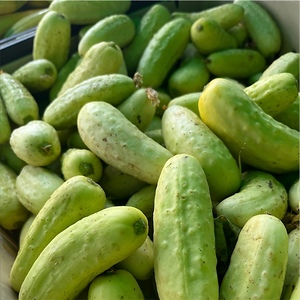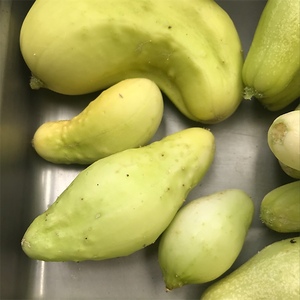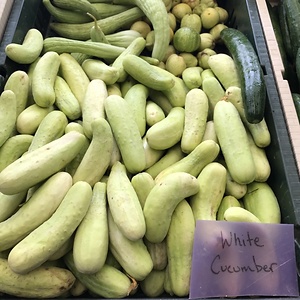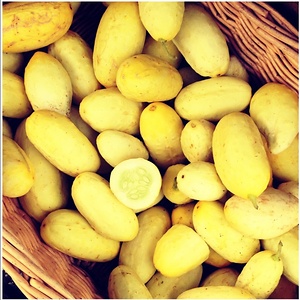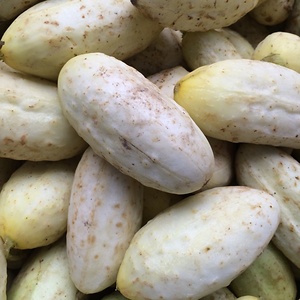

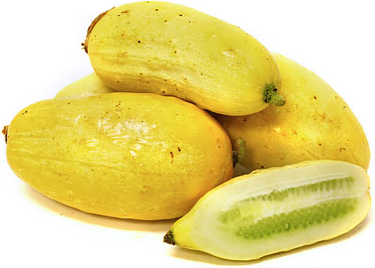
Miniature White Cucumbers
Estimated Inventory, lb : 0
Description/Taste
Miniature White cucumbers are small, averaging 5 to 10 centimeters in length, and have a cylindrical shape with curved, blunt to slightly pointed ends. The skin is thin, bumpy, and lightly covered in black-tipped spines, ripening from green when young to shades of white, pale yellow, or bright yellow with maturity. Underneath the surface, the pale-yellow flesh is tender, aqueous, and crisp with a snap-like quality. The flesh also encases a narrow, central cavity filled with pliable, ivory seeds suspended in a pale green, gelatinous liquid. Miniature White cucumbers have a mild, sweet, and subtly green flavor without the bitter taste commonly associated with other white cucumber varieties.
Seasons/Availability
Miniature White cucumbers are available in the summer.
Current Facts
Miniature White cucumbers, botanically classified as Cucumis sativus, are a specialty pickling variety belonging to the Cucurbitaceae family. The pale cucumbers are not grown commercially and are primarily cultivated as a gourmet variety through small farms and home gardens. Growers favor Miniature White cucumber plants for their compact nature, developing climbing vines that extend less than one meter in length, and the plants can be grown in containers for small spaces. The variety is also valued for its early-maturing fruits that produce continuous, high yields when in season. Miniature White cucumbers have thin, crisp, and sweet flesh that can be consumed fresh or pickled. The variety is seasonally used as a refreshing, cooling ingredient in a wide array of culinary applications.
Nutritional Value
Miniature White cucumbers are a source of vitamin K to promote faster wound healing, vitamin C to strengthen the immune system, and potassium to regulate fluid levels within the body. The cucumbers also provide lower amounts of magnesium, manganese, and fiber. In natural medicines, cucumbers are believed to soothe, cool the body, and help aid in flushing toxins from the digestive tract.
Applications
Miniature White cucumbers are best suited for fresh, cooked, and pickled applications. The cukes have thin skin that does not need to be peeled before eating, and the flesh has a sweet flavor without bitterness, providing a refreshing, mild taste. Miniature White cucumbers can be consumed straight, out-of-hand, or can be sliced and tossed into green salads, chopped into salsa, served with herbal dips as a snack, blended into gazpacho, or cut and layered onto sandwiches. The variety can also be used as an edible garnish in cocktails, juiced and served as a cooling beverage, or used to flavor sparkling water. In addition to fresh applications, Miniature White cucumbers are pickled for extended use and can be served as a briny condiment with burgers, grilled cheese, and roasted meats. The cukes can also be fried into poppers, pureed into hummus, wrapped in thinly sliced meats as a bite-sized appetizer, or incorporated into curries, stir-fries, and roasted vegetable dishes. Miniature White cucumbers pair well with herbs such as basil, dill, shiso, and chives, lemon juice, ranch, yogurt, vinegar, meats such as roast beef, ham, and poultry, tomatoes, bell peppers, celery, fennel, leafy greens, and radishes. Whole Miniature White cucumbers should be individually wrapped in paper towels and stored in a plastic bag in the refrigerator, where they will keep for 2 to 7 days.
Ethnic/Cultural Info
Miniature White cucumbers are a favorite home garden variety in the United States and are frequently used as a specialty cultivar in local pickling competitions. The sweet cukes have an unusual appearance due to their pale coloring, and the thin skin helps to develop a crisp, snap-like quality when fermented. Each year around Memorial Day Weekend, Pickle Packers International, an American trade association for the pickle industry, hosts a ten-day International Pickle Week that features pickle varieties such as Miniature White cucumbers. The annual event is one of the longest-running promotional food weeks in the United States, first held in 1948, and has been celebrated for over fifty years. During the week, many different events are held across the county, including pickle taste tests, pickle eating contests, and a pickle juice drinking contest. The celebration also hosts networking mixers to connect pickle enthusiasts, allowing attendees to discuss their favorite cucumber varieties, best cultivation techniques, and pickling methods.
Geography/History
Cucumbers are native to South-Central Asia and have been cultivated for thousands of years. The first varieties were spread to East Asia and Europe in early times through trade routes, and extensive cultivation of the fruits led to many different cultivars ranging in size, color, and flavor. In ancient times, cucumbers were primarily pickled, which was the most used preservation method in Mesopotamia around 2400 BC. Over time, growing cucumbers in home gardens became common throughout Europe and the American colonies. Varieties of white cucumbers have been present since the early ages but were first mentioned in 1727 by Stephen Switzer in his book, "The Practical Kitchen Gardener." While the exact history of Miniature White cucumbers is unknown, the variety was believed to have been created from common white cucumber cultivars. Today Miniature White cucumbers are grown as a home garden variety in Europe and the United States.
Recipe Ideas
Recipes that include Miniature White Cucumbers. One



